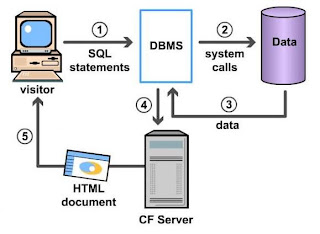What
is a Database?
• A database is any
collection of related data.
• A database is a
persistent, logically coherent collection of inherently meaningful data,
relevant to some aspects of the real world.
What
is a Database Management System?
A database management
system (DBMS) is a collection of programs that enables users to create and
maintain a database. According to the ANSI/SPARC DBMS Report (1977), a DBMS should
be envisioned as a multi-layered system:
Function
of DBMS:
The
main functions of operating systems are as follows:
Process
Management: As a process manager, the OS handles the creation and
deletion of processes, suspension and resumption of processes and scheduling
and synchronisation of processes.
Memory
Management: As a memory manager, the OS handles allocation and
reallocation of memory space as required by various programs.
File
Management: The OS is responsible for creation and deletion of files
and directories. It also take care of other file- related activities such as
organising, storing, retrieving, naming and protecting the files.
Device
Management: OS provides input/output subsystem between process and
device driver. It handles the device cache, buffers and interrupts. OS also
detects device failure and notifies the same to the user.
Security
Management: The OS protects system resources and information
against destruction and unauthorized use.
User Interface: OS
provides the interface between the user and the hardware . The user interface
is the layer that actually interacts with the computer operator. The interface
consists of a set of commands or menus through which a user communicates with a
program.
Various Levels of DBMS:
A
DBMS is implemented through three general Levels:
External
Level: This is the level closet to the users and is concerned
with the way in which the data are viewed by individual users. For example,
even though the bank database sores a lot much information, an account holder
(a user) is interested only in his account details and not with the rest of
information stored in the database.
Conceptual
Level: This level of abstraction
describes what data are actually stored in the database. It also describes the
relationships existing among data.
Internal Level: This is the closest to physical storage. This
level is also sometimes termed as physical level. It describes how the data are
actually stored on the storage medium.


Customer care_helpline number
ReplyDelete-9264461998-7047303458
Any-problem call my agent (24*7) house-contect hair
_toll free _1800300989/6291633469
Head office (all-india) but your language in Hindi and English---
Your problem solved-solved-
mer Care number_7047303458
-7478897537
(All-india) contact hair_my head office
Call my assistant 24 hours available anyone______
Contact hair_7063539605-8436046948
Head office-7478897537-
Mba Customer care_helpline number
-9264461998-7047303458
Any-problem call my agent (24*7) house-contect hair
_toll free _1800300989/6291633469
Head office (all-india) but your language in Hindi and English---
Your problem solved-solved-
mer Care number_7047303458
-7478897537
(All-india) contact hair_my head office
Call my assistant 24 hours available anyone______
Contact hair_7063539605-8436046948
Head office-7478897537
Great article, thank you for the valuable information.
ReplyDeleteBest Data Management Services Company/a>
Really appreciate your post, and you explain each and every point very well. Thanks for sharing this information.
ReplyDeleteMaster data management companies